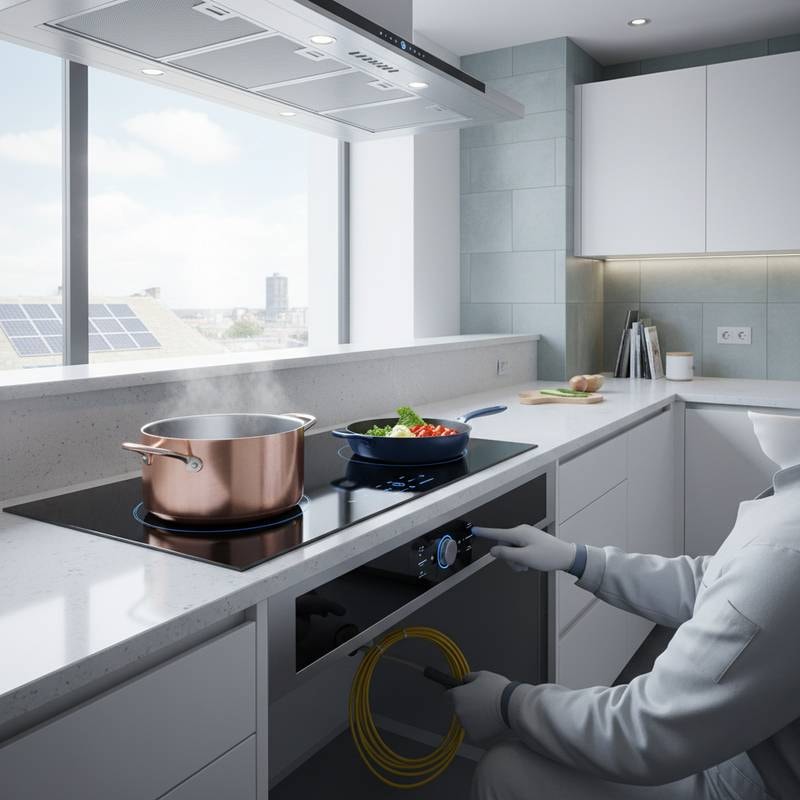Induction Zones: Ditching Gas for Smarter Kitchens
As a remodeling contractor, I have observed the kitchen transform from a basic functional area into the technological center of the home. One prominent change involves homeowners transitioning from gas cooktops to induction models. This shift represents more than a stylistic preference. It qualifies as a practical choice grounded in safety, efficiency, and daily performance improvements.
The Hidden Costs of Gas Cooking
Numerous homeowners maintain the view that gas provides superior control and performance. This perception held validity in earlier times, yet it involves significant drawbacks that become evident only after prolonged use.
Gas appliances generate combustion within the living environment. Such processes release carbon monoxide, nitrogen dioxide, and fine particulates, all of which compromise indoor air quality. In multiple kitchens I have inspected, the vent hood proves inadequate, resulting in residue accumulation on cabinets and a persistent grease layer on surfaces. This gradual buildup erodes finishes, accelerates wear on paint and cabinetry, and clogs HVAC filters prematurely.
Gas lines present additional maintenance challenges and liability risks. A minor leak may remain undetected until it escalates into a hazardous situation. Local regulations mandate appropriate venting and periodic inspections, though many legacy kitchens fail to comply with contemporary requirements. Clients frequently encounter unexpected expenses when upgrading or replacing these systems during renovation projects.
Why Induction Makes Sense Now
Induction cooking employs magnetic fields to heat pots and pans directly, bypassing the cooktop surface. This method eliminates open flames, minimizes heat loss, and accelerates response times. Practically speaking, water reaches a boil in approximately half the duration compared to gas, while simmers hold steady without frequent adjustments.
From a contractor perspective, induction installations streamline the design process. Planners avoid accommodating oversized vent hoods or gas line clearances. This flexibility proves advantageous in compact kitchens or island configurations. Furthermore, induction generates minimal ambient heat, enhancing room comfort and easing the burden on air conditioning units.
To illustrate energy efficiency, consider a standard household. An induction cooktop uses up to 90 percent of its energy for cooking, compared to gas models that lose much of their output to surrounding air. Over a year, this translates to noticeable reductions in utility bills, often by 20 to 30 percent for frequent cooks.
Common Misconceptions About Induction
Homeowners frequently express concern that induction demands specialized cookware. While this holds some truth, the majority of contemporary stainless steel and cast iron pieces prove compatible. Test compatibility by attaching a magnet to the pan base; adhesion confirms suitability. The primary adaptation involves acclimating to the system's responsiveness, as heat levels shift immediately upon adjustment. With brief practice, this feature enhances precision and becomes intuitive.
Upfront costs represent another frequent hesitation. Induction units carry a higher initial price tag than basic gas alternatives. However, energy savings and reduced ventilation needs offset this within three to five years for average users. The design features fewer components prone to wear, leading to lower repair rates. In my installations, induction systems have operated flawlessly for over a decade without requiring service.
Planning an Induction Upgrade
For conversions from gas, begin by evaluating electrical infrastructure. Induction cooktops generally necessitate a dedicated 240-volt circuit. Engage a licensed electrician to confirm that the service panel supports the additional load prior to appliance selection. Electrical service upgrades may incur extra expense, but they guarantee reliable and secure operation.
Ventilation remains essential, even with induction's cleaner profile. The system manages odors and steam effectively, yet proper extraction prevents moisture buildup and protects surfaces. Select a robust vent hood or integrated downdraft unit rated for the cooktop's output, typically measured in cubic feet per minute (CFM). Aim for at least 400 CFM in standard setups to maintain air quality.
Countertop preparation demands precision. Induction models differ in depth and ventilation requirements, so review manufacturer dimensions early. Coordinate with fabricators before cutting quartz, granite, or laminate to avoid costly alterations. For instance, some units require specific overhangs for downdraft integration, which influence overall layout.
The Long-Term Payoff
Adopting induction extends beyond immediate convenience. It prioritizes safety through the absence of combustion risks, boosts efficiency with targeted heating, and prepares the kitchen for evolving regulations. Bans on new gas installations appear in numerous cities, from Berkeley to New York, signaling a broader trend. Properties equipped with induction often attract buyers seeking compliance with updated codes, potentially accelerating sales and elevating value by five to ten percent.
Maintenance simplifies dramatically with induction. The smooth glass surface wipes clean in seconds, free from grates, burners, or ignition components. This ease aligns with current preferences for streamlined, contemporary designs that emphasize functionality and aesthetics.
Integrating Induction into Your Kitchen Design
During a remodel or appliance replacement, assess induction viability early. Consult your contractor on electrical assessments, ventilation options, and size compatibility to inform decisions. Proactive measures in the planning phase avert substantial rework and expenses downstream.
Homeowners who adopt induction typically express satisfaction with its precision, safety, and efficiency after initial use. The technology integrates seamlessly into modern lifestyles, delivering reliable performance that enhances daily cooking experiences.









